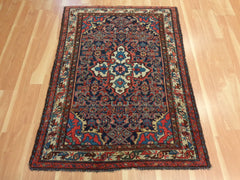Hamedan Rugs
What Are Hamadan Rugs?
Hamadan rugs are a type of Persian rug. They are hand knotted rugs woven in Hamedan. The city of Hamadan (Hamedan) can be found in western Iran in the province which is also called Hamedan. It is one of the largest weaving areas in the region and encompasses hundreds of villages. Each one of these villages has its own characteristic weaving tradition that dictates the patterns and sizes of the rugs made there. Some of these types include Bibikabad, Ingeles, Borchelou, Dergazine, and Hussainabad.
A typical Hamedan rug is pictured below.

Characteristics of Hamadan Rugs
The majority of rugs woven in the Hamadan region use the same color palette of primary colors with ivory, red, blue or brown backgrounds. Hamadan designs are generally simple and usually incorporate floral elements. They also can have hexagonal or diamond shaped designs. Smaller Hamadans typically have a pattern which consists of a central diamond-shaped medallion. Larger rugs and runners can contain three or more medallions. Medallions found in Hamadans can contain geometric figures, floral designs, serrated lines, or hooks among other patterns.
Herati designs are one of the most famous patterns found in Hamadans and are named after the village of Herat. The Herati pattern is not exclusive to Persian rugs and can be found in rugs of different origins. It consists of a rosette set in a diamond shape surrounded by curved leaves which may be serrated. These leaves may also be called "mahi" because they resemble fish. The design can be observed in the field surrounding the medallion in the Tajabad Hamedan rug below.

Hamadan rugs are almost always woven on cotton foundations. Both the Turkish knot and the Persian knot can be found in different types of Hamadan rugs.
Camels hair was used more often in the pile of older Hamadans for its color which contrasted well with the bright shades of blue, red and yellow found in other parts of the rug. When wool is used for the pile it ranges from coarse to medium in quality. The pile is usually sheared to a medium height. Sizes of Hamadan rugs vary among villages but most are made in smaller sizes from mats to 9’ x 12’ and runners. Hamadan rugs are overall less expensive than other types of Oriental rugs.
Types of Hamadan Rugs:
Bibikabad (View Article)
Dergazine (View Article)
Enjilas (Ingeles, Enjeles) (View Article)
Hussainabad (View Article)
Kabudrahang (Kapoutrang, Kabutarhang) (View Article)
Lilihan (Lilian, Lylyan) (View Article)
Melayer (View Article)
Maslaghan (View Article)
Nahavand (Nehavend)
Rudbar (Roudbar)
Saveh
Tafresh
Tajabad (Tajiabad)
Touserkan (Tuisarkhan)
View more Hamedan rug examples on our Pinterest Board!







